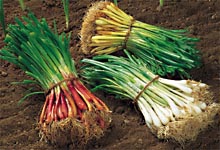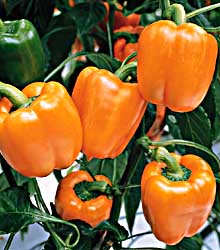

 |
 |
| Some gardeners
today save seed but not nearly as many as in the past. We do have
generations of seed savers to thank for the heirlooms we enjoy today.
Just as there are a number of reasons why you might want to grow heirlooms
in the first place, there are also several sound motives for saving the
seed from the old time vegetables grown in your own garden. It's
obviously cheaper (as in free) to save your own seed, you get the satisfaction
of continuing the line of your favorite vegetables and you're ensuring
the seed supply for those varieties you've grown and know to be well adapted
to your area. It's fun to be able to give family and friends seeds
you'd like to encourage them to grow, too. You also want to preserve
particular seed stocks. Just because you've been able to buy a special
variety in the past doesn't mean it will always be available. Finally,
by saving seed, you're contributing to the biodiversity of vegetable germplasm.
Now that we've covered the reasons why you might want to save seeds, lets cover the how of seed saving. There's more to it than just keeping a few bean seeds. On the other hand, bean seeds are a good place to start. Seed saving success depends on the size of your garden, the types of vegetables you grow and the amount of time you have. The best thing to do is to start with just one, easy crop like peas, tomatoes, peppers or those beans. These self-pollinating annuals represent the least complicated type in terms of preserving seed.
For cross-pollinating annuals, such as cucumbers, squashes, melons, pumpkins or gourds (the cucurbit family), things get a little more complicated. If these plants are too close to each other, they will cross-pollinate and give you results you might not have planned on. One woman got a cross between a striped summer squash and an acorn squash. The outcome was a striped, tough skinned, stringy summer squash. These types need to be hand-pollinated which involves taping both kinds of blossoms. For the details on this, please see an excellent book on the subject, "Seed to Seed" by Suzanne Ashworth, available from Seed Savers Exchange (319-382-5990, 3076 N. Winn Rd., Decorah, IA 52101). You may have to isolate or grow a variety separately. Some varieties may need to stay in the garden longer than normal to let the seed mature. Lettuce, for instance, may have to be allowed to bolt; cucumbers may have to stay on the vine longer than they would for a normal harvest. Biennials are the third type of vegetables. These have a two-year growth cycle. In the first year, their growth is vegetative and we eat parts of these plants: carrots, beets, turnips, to name a few. During the second year, reproductive growth leads to the setting and maturing of seeds. Again, you'll need to consult a reference for all the specifics if you want to save these kinds of seeds. Some seeds you just save, as in the case of peas and beans. Others need to ferment to destroy soil borne disease (cucumbers and tomatoes).
Dry your seeds in a warm, dry area that has good air circulation. Avoid all heat sources including an oven or the sun. Storage should be done in a cool, dark environment with little or no temperature variation -- refrigerators are ideal. Use a dessicant such as silica gel or powdered milk. How long will seeds last and still be viable for germination? Most varieties are good for 3 to 5 years. Members of the allium family, such as onions and leeks and parsnips can be counted on to perform only within a year after seed harvest while members of the squash or cucurbit family can go as long as 10 years with good care. |
| Home | Definition | History | Why Grow? |
| Old vs. New | Growing Tips | Harvest & Storage | Saving Seed |
 |
| Sampling | Public Gardens | Seed Exchanges | Seed Companies | Bibliography |